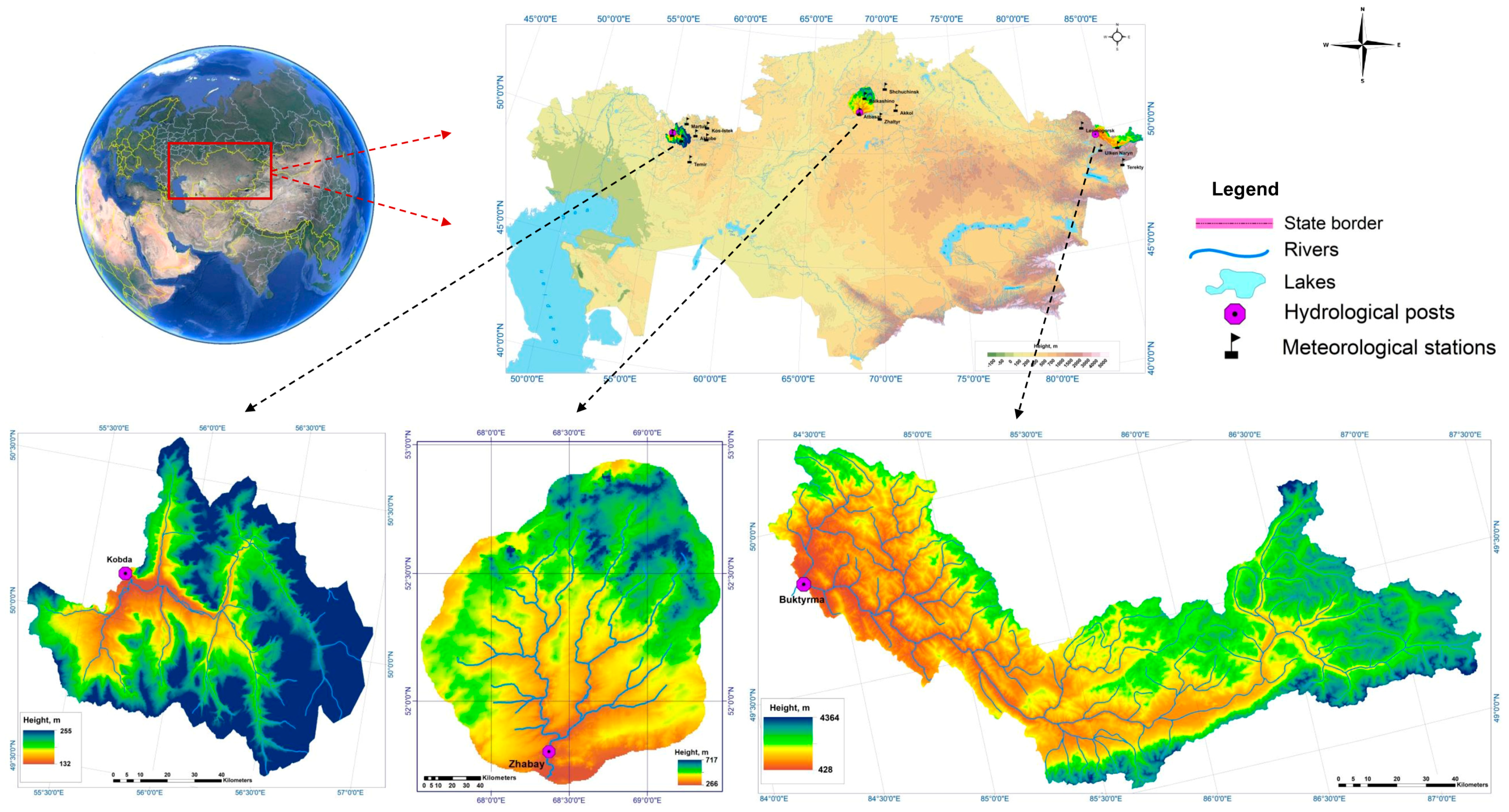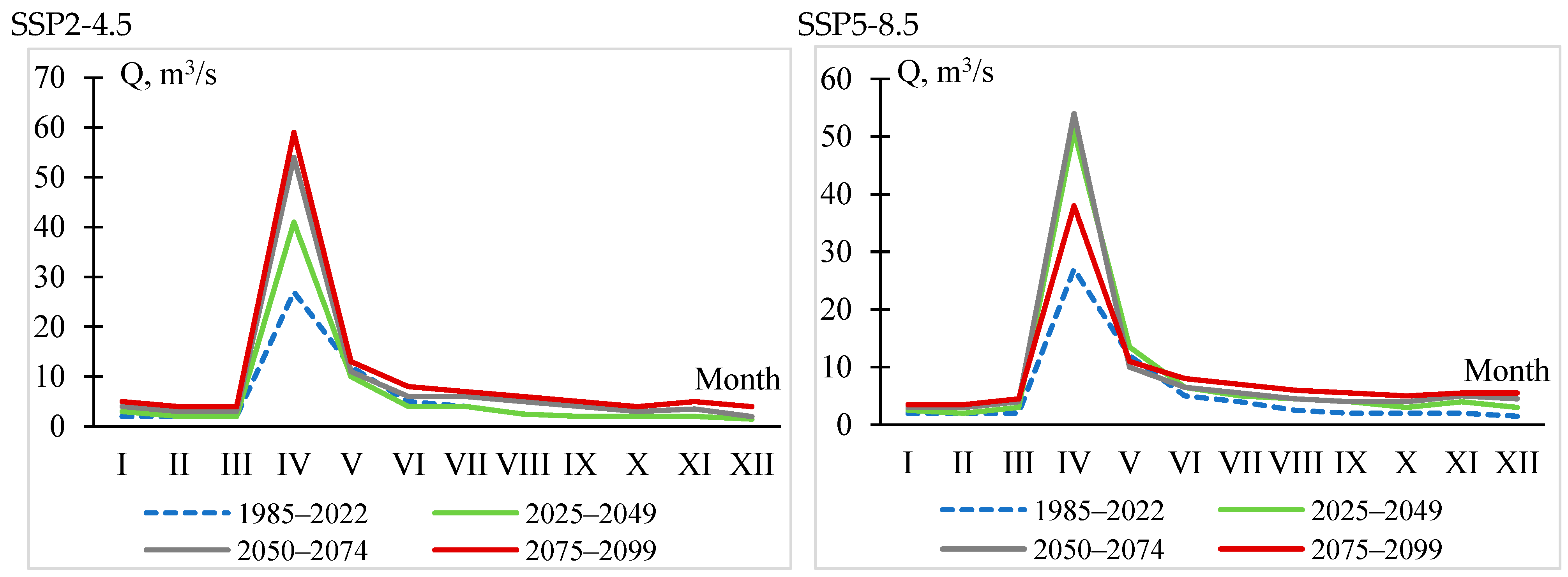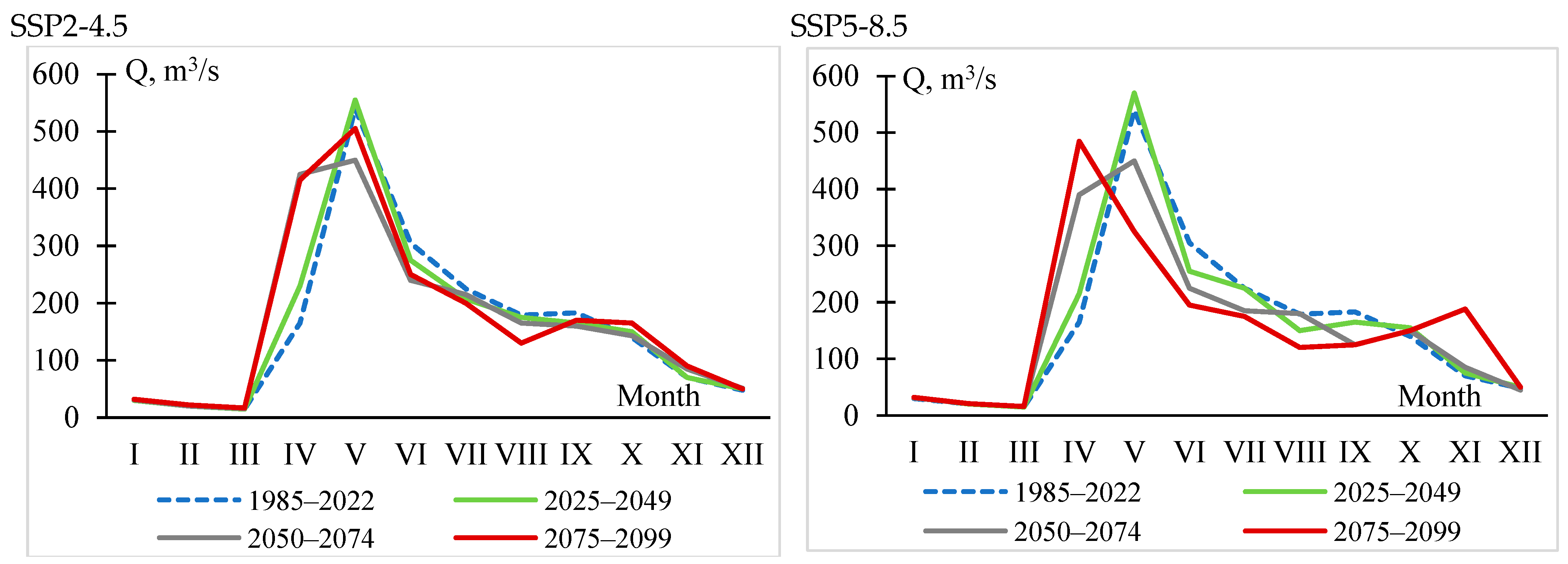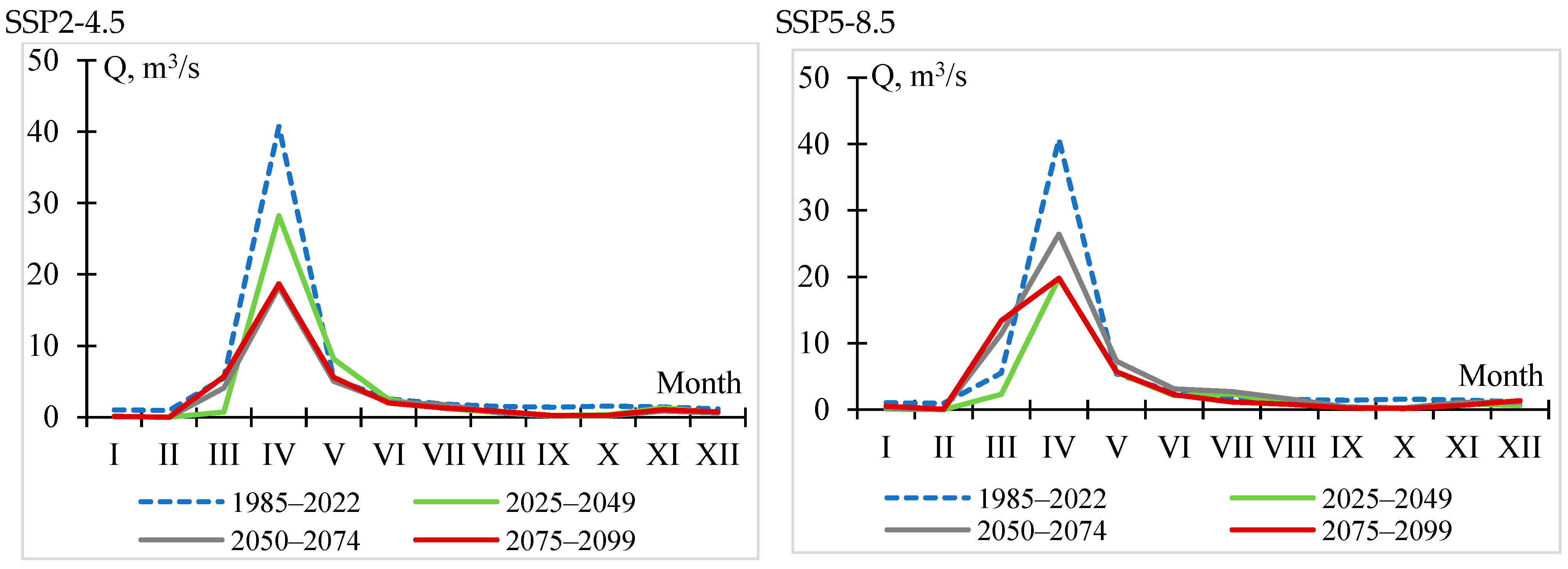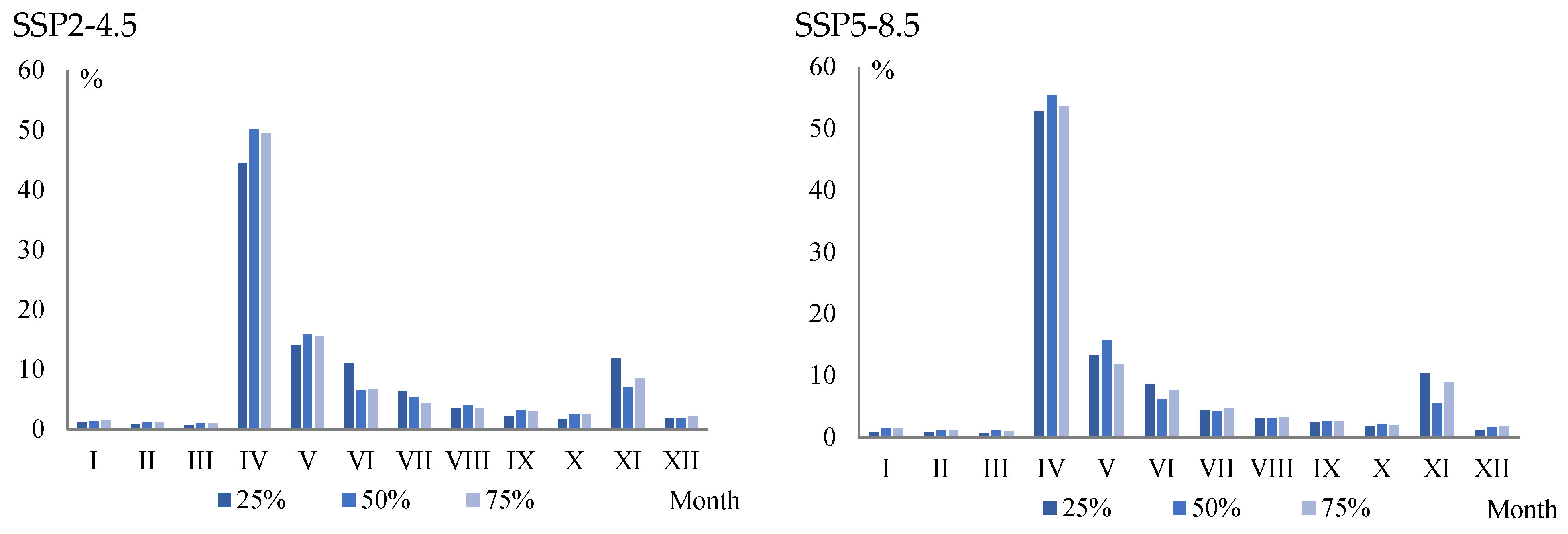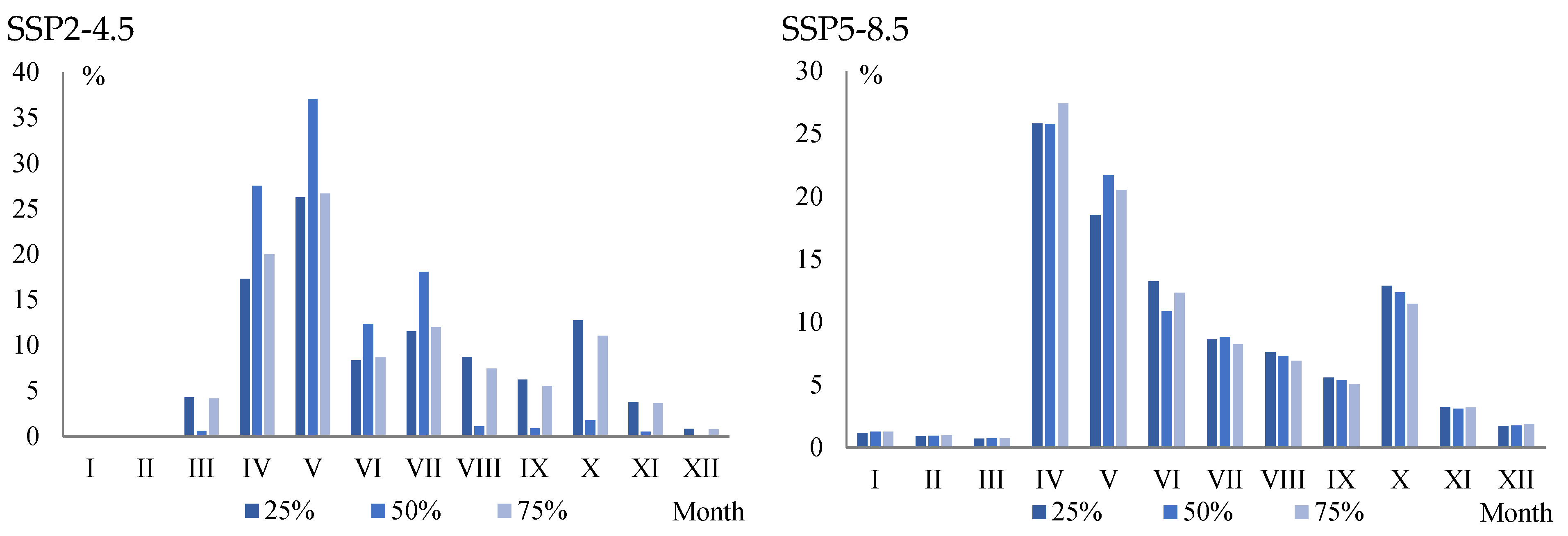5.2. Forecast Runoff of the Studied Rivers
According to averaged data from global models under the scenarios of greenhouse gas concentrations SSP2-4.5 and SSP5-8.5, the forecast values of water runoff for the studied water bodies were modelled. These climate models satisfactorily describe the current temperature and precipitation regime in the study regions [
60]. In accordance with the recommendations of the World Meteorological Organisation (WMO), 25–30-year periods (climatic ‘norms’) are used as the international standard for calculating the average annual values for temperature, precipitation and other meteorological indicators [
61,
62]. This ensures the comparability of results from different studies and regions, and provides an objective basis for assessing the degree of deviation of current weather conditions from typical conditions.
Figure 2,
Figure 3 and
Figure 4 show representative seasonal dynamics of river flow over the last 40 years (from 1985 to the present) and for three periods (2025–2049, 2050–2074, 2075–2099). The analysis based on these intervals allows for the identification of stable climate trends and provides a scientifically sound basis for climate and water resource management planning.
Figure 2 shows the results for Zhabay river basin. For the historical period (1985–2022), the average annual flow rate of the Zhabay river is approximately 13 m
3/s, with characteristic seasonal fluctuations. There is a reduction in the flow during the winter months (<10 m
3/s) and a district peak during the summer months due to snowmelt and increased precipitation.
According to the modelled water discharges (under the SSP2-4.5 scenario), on the river Zhabay—near the city of Atbasar—during the period from 2025 to 2049, the flood peak will be increased approximately 1.5 times (from 27 to 41 m
3/s). From 2050 to 2074, there will be an even greater increase in the river water content in April, reaching an increase in the flood peak by 2 times (from 27 to 54 m
3/s). Further from 2075–2099, the streamflow continues to increase. Since the Zhabay river basin exhibits significant seasonal and long-term variability in flow, which hinders the effective use of water resources and leads to significant damage, as evidenced by the floods of 2014, 2017, and 2024 in the city of Atbasar [
10,
11,
12,
13], understanding possible changes in the frequency and magnitude of floods on the Zhabay river is crucial for improving flood management strategies and ensuring water security in the region.
The results obtained under the SSP5-8.5 scenario on the Zhabay river show a similar situation. During the period from 2025 to 2049, the flood peak will be increased by about 1.9 (from 27 to 51 m3/s) times. From 2050 to 2074, there is an even greater increase in water availability in the basin in April, reaching a 2-fold increase in flood peak. Further from 2075–2099, the river discharge decreases again, but there is still a pronounced increase in flood peak magnitude relative to the historical observations.
Figure 3 shows that, according to the results obtained, scenario SSP2-4.5 is characterised by moderate climate transformation, with peak flood flows for the period 1985–2022 mainly formed by snowmelt from glacial and snow-covered areas, reaching values of around 500–550 m
3/s. In the near future, 2025–2049, no significant changes in the volume and form of spring floods are expected—water consumption in the peak month is also forecast at 550 m
3/s. The second period (2050–2074) is characterised by the maximum flow spreading over two months—April and May—and fluctuating between 420 and 450 m
3/s. This trend indicates the faster melting of snow cover and glaciers due to rising temperatures. After 2075, there will be a 2.5-fold increase in the river’s water content in April, and high-water levels will also be observed for two months in a row, but the peak will still be reached in May—505 m
3/s. At the same time, high seasonal contrast remains: summer and autumn flow rates remain low, indicating an increased risk of low-water periods.
Scenario SSP5-8.5 reflects more intense warming and sharp changes in climatic factors. In the base period, the spring peak is similar to the previous scenario (500–550 m3/s), while, during the period 2025–2049, there is a slight increase in maximum flow to 570 m3/s. During the period 2050–2074, the flood peak spreads over two months, with the maximum remaining in May at 450 m3/s. The period from 2075 to 2099 is characterised by a shift in the peak flood period from May to April and a sharp decrease in summer flows, reflecting the impact of glacier degradation and the intensification of extreme hydrological phenomena.
The results obtained for the Buktyrma river basin show that glacier degradation in the context of climate warming will contribute to a short-term increase in summer runoff due to accelerated melting, but in the long term, this will lead to a decrease in summer runoff and an increase in seasonal contrast.
The average annual flow for the historical period (1985–2022) is 5.29 m
3/s. According to the SSP2-4.5 scenario (
Figure 4), the average annual flow for the period 2025–2049 is 3.68 m
3/s, which is 30.5% lower compared to the historical period. This scenario can be attributed to moderate climate perturbations that affect precipitation and snow cover, resulting in reduced flows in the river.
The analysis of flow changes for the forecast periods showed a significant decrease in the water resources of the Ulken Kobda river for both scenarios SSP2-4.5 and SSP5-8.5 compared to the baseline historical period (
Figure 4).
Under the SSP5-8.5 scenario, the average annual flow for the period 2025–2049 is around 2.93 m3/s, which is 44.8% lower than the historical value, indicating a more significant reduction. This trend can be attributed to more pronounced climatic changes, including higher temperatures, lower precipitation, and earlier snowmelt.
A comparison of the runoff changes between the two scenarios (SSP2-4.5 and SSP5-8.5) shows that the impact of more severe climatic conditions under the SSP5-8.5 scenario leads to a significant reduction in runoff, by 44.8% (from 5.29 to 2.92 m3/s), in contrast to the more moderate reduction under SSP2-4.5, where the reduction was 30.5% (from 5.29 to 3.68 m3/s). These data confirm that higher levels of greenhouse gas emissions, accompanied by intense climate change, lead to more dramatic reductions in water resources.
Table 3 presents the results of the CMIP6 multi-model ensemble calculations for the predicted annual runoff for the three rivers studied under the SSP2-4.5 and SSP5-8.5 climate change scenarios. For each scenario and time period (2025–2049, 2050–2074, 2074–2099), the 5th and 95th percentiles for the model ensemble are given, which allows for a quantitative assessment of the range of inter-model variability.
5.3. Forecast of Intra-Annual Distribution of River Runoff
A calculation and analysis of the intra-annual runoff dynamics of the Zhabay river was carried out for the forecast period up to 2099 under two scenarios (SSP2-4.5 and SSP5-8.5) for phases of varying water content. Climate change under both scenarios will have a significant impact on the formation, distribution, and seasonal structure of the Zhabay river’s flow. The analysis shows how the intra-annual regime is transformed under global warming conditions. According to CMIP6 scenarios, key climate changes in the Zhabay region include [
31] the following:
- -
An increase in mean annual air temperature (up to +2–4 °C depending on the scenario);
- -
Shortening the duration of the snow period and decreasing snow reserves by the end of winter;
- -
Acceleration of snowmelt in spring, leading to abrupt and short-lived floods;
- -
Increased evapotranspiration in summer, which increases soil moisture deficit and reduces runoff;
- -
A possible increase in precipitation during transitional seasons (autumn), mainly in the form of rainfall.
The combination of these factors forms the key trends in the change of the Zhabay river flow (
Figure 5).
In both scenarios, there is a pronounced seasonality of runoff, dominated by the spring flood (April–May), which accounts for 44 to 55% of the annual volume. During the summer–autumn period (June–November), the contribution decreases significantly to between 18 and 25%, with November showing a localised increase in the runoff share.
The maximum volume of meltwater accumulates in the snowpack during the winter and is released over a short period in spring, resulting in a pronounced runoff peak in April. This pattern is especially distinct in high-flow and average-flow years under both climate scenarios. In contrast to the spring season, October is characterised by significantly lower runoff, which is governed by the end of the vegetation period, reduced evaporation, and moderate precipitation, predominantly in the form of rain. In certain years, a minor increase in runoff may be observed in October, attributed to late-autumn rainfall or specific features of subsurface flow dynamics. However, neither the magnitude nor the intensity of these processes is comparable to that of snowmelt-driven spring floods. Under current climatic conditions, the increasingly earlier termination of the solid precipitation and stabilisation of temperature patterns also contribute to the limited contribution of autumn runoff by inhibiting rapid surface water inflow. Thus, the contrast between the pronounced April peak and the episodic rise in October runoff in the Zhabay river is primarily driven by the dominant role of snowmelt in shaping the spring hydrological regime, whereas autumnal processes have a secondary influence, contributing only to localised anomalies through atmospheric precipitation and delayed groundwater discharge. The winter period (December–March) is characterised by extremely low values of less than 5% of annual runoff, which is typical of the continental climate of the region (
Table 4).
According to the SSP2-4.5 scenario, in high-water years (25 per cent), the flood peak occurs in April (44.5 per cent), with notable contributions also in May (14 per cent) and June (11.1 per cent). In autumn, there is a secondary peak in November (11.9%). Winter months cumulatively contribute about 4.7 per cent.
In average water years (50%), April (50.1%) and May (15.8%) form the bulk of the runoff. The summer months are characterised by a decrease to 3–6%. The autumn maximum in November is weakened (6.9%).
In low-water years (75%), the spring peak persists (April—49.4%), whilst summer and autumn months are of limited importance. November increases again (8.5%) as a secondary peak. Winter values are minimal.
However, under scenario SSP5-8.5, in high water years, there is a significant strengthening of spring flows—up to 52.8% in April. The summer months are weakened and a local maximum (10.4%) is again recorded in November. Winter values are less than 3.5 per cent.
In mid-water years. April becomes dominant (55.4%), and May less so with 15.6%. Summer runoff is limited (less than 6%), and November yields 5.5%. Winter is extremely low (1–1.4%).
In low-water years (75%), April (53.7%) remains the main month of flow formation, with May (11.8%) decreasing in importance. Summer and winter have almost no pronounced contribution, with November again showing an increase (8.9%).
Spring floods will increase under extreme climatic scenarios, with the runoff concentration in April. Summer will become even more low-water, especially at SSP5-8.5, which may affect water supply during the growing season. Increased runoff in November may indicate a shift in seasonal precipitation or a change in snowmelt dynamics. Winter runoff loses its hydrological significance and requires a separate analysis in the context of channel freezing and water system management (
Table 5).
Thus, there is an increased seasonality of runoff and a growing intra-annual contrast between spring and the rest of the seasons, especially under conditions of intense climatic change under the SSP5-8.5 scenario.
The CMIP6 climate scenarios in the Buktyrma river basin assume [
31] the following
- -
An increase in air temperature of 2–4 °C, depending on the scenario and season;
- -
A reduction in snow cover accumulation in winter, especially under SSP5-8.5;
- -
An acceleration of spring snowmelt and an increase in the proportion of precipitation in the form of rain during the warm season;
- -
The increased intensity and frequency of autumn and summer showers;
- -
A reduction in glacier storage in the highlands, which reduces the steady flow in the summer season.
These changes directly affect the hydrological regime of the Buktyrma mountain river (
Figure 6).
In all water availability variants, the main part of the annual runoff is formed during April–July, with a peak in May or April depending on the scenario. The autumn period (August–November) is also characterised by an additional contribution due to heavy precipitation. The winter period (December–March) remains low water, although there a modest increase in winter discharge is indicated under SSP5-8.5 (
Table 6).
According to the SSP2-4.5 scenario, in the temperate climatic scenario, the traditional runoff distribution for mountain rivers is maintained, with a dominance of the May peak:
In high-water years, the runoff peaks are in May (26.2 per cent), with significant contributions also in July (11.5 per cent) and October (12.7 per cent). April and June are also active, which corresponds to the nature of spring–summer snowmelt. Winter runoff is mainly formed in March (4.3 per cent).
In average water years, runoff distribution is concentrated in May (37%) and July (18%). The contribution of autumn months is minimal, especially in August–November. Winter runoff is practically absent.
In dry years, the May maximum (26.7 per cent) and October secondary peak (11.0 per cent) persist. March also remains relatively active (4.2%).
Thus, in SSP2-4.5, the Buktyrma river is characterised by a two-stage flow structure—with the high flows in spring and autumn (October).
According to the SSP5-8.5 scenario, under enhanced warming, significant changes in runoff patterns characteristic of mountain basins are observed:
In high-water years, peak runoff shifts from May to April (25.8%), which is associated with accelerated snowmelt. The May contribution decreases (18.5%), while June and October remain significant (13.2% and 12.9%, respectively). Winter runoff increases, up to 4.5% in total, which may be related to the increased frequency of winter thaws or the transition of precipitation to the liquid phase.
In average water years, there is an even distribution of spring runoff between April (25.8%) and May (21.7%), with moderate values in June (10.9%) and October (12.4%). Winter runoff is about 4.9% of annual runoff.
In low-water years, April becomes the main runoff month (27.4%), while May and June also remain active. October shows a steady contribution (11.4%), winter—up to 4.9%.
For the Ulken Kobda river, under scenario SSP2-4.5—under moderate climate change—spring remains the main flow season, but summer flow gradually decreases due to decreased summer precipitation and increased temperature. Winter remains relatively stable, with minimal change. Under scenario SSP5-8.5—under more extreme climate change—although there will still be more water in the summer, under more extreme climate change, winter runoff will increase and summer runoff will decrease, changing the distribution of runoff by month and season. This is due to warmer winters, changes in precipitation patterns (with increased winter precipitation in the form of snow), and more intense snowmelt.
In order to assess the impact of climate change on the long-term flow distribution of the Ulken Kobda river, data on the intra-annual flow distribution were analysed based on two climate scenarios derived from the CMIP6 model (
Figure 7).
Climatic changes projected under scenarios SSP2-4.5 and SSP5-8.5 could significantly affect the flow distribution of the Ulken Kobda river in the future, with a shift in peak flows towards the winter period and a reduction in summer flows (
Table 7).
According to scenario SSP2-4.5, in high-water years, spring (April–May) accounts for 57.1 per cent of the annual runoff, while the summer period (June–August) gives 16.1 per cent in May and 4.8 per cent in June. The autumn and winter periods have lower rates, with 1.3% in September and 14.8% in March.
In average water years, spring accounts for 59.5% of the total runoff, summer accounts for 17.8%, autumn accounts for 5%, and winter accounts for 13.2%.
In low-water years, spring receives 63% of the runoff, summer and autumn have minimal contribution, and the winter period is 13.8%.
According to scenario SSP5-8.5, in high-water years, spring accounts for 48.3% of the annual runoff, which is 8.8% lower than in the SSP2-4.5 scenario. Summer runoff decreases to 14.4% and autumn runoff to 5.8%. Winter increases significantly, reaching 23%.
In average years, 55.2% of runoff is given in spring, 14.7% in summer, 4.9% in autumn, and the winter period increases to 15.7%.
In low-water years, 58.5% of runoff is given in spring, whilst summer and autumn lose a significant part, and the winter period is 6%.
